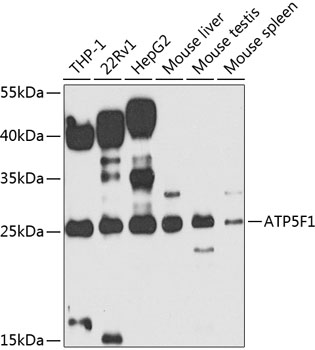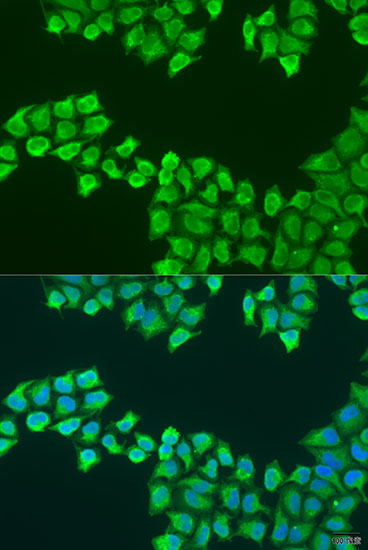Signal Transduction Antibodies 3
Anti-ATP5F1 Antibody (CAB7645)
- SKU:
- CAB7645
- Product Type:
- Antibody
- Reactivity:
- Human
- Reactivity:
- Mouse
- Host Species:
- Rabbit
- Isotype:
- IgG
- Antibody Type:
- Polyclonal Antibody
- Research Area:
- Signal Transduction
Description
| Antibody Name: | Anti-ATP5F1 Antibody |
| Antibody SKU: | CAB7645 |
| Antibody Size: | 20uL, 50uL, 100uL |
| Application: | WB IF |
| Reactivity: | Human, Mouse |
| Host Species: | Rabbit |
| Immunogen: | Recombinant fusion protein containing a sequence corresponding to amino acids 1-245 of human ATP5F1 (NP_001679.2). |
| Application: | WB IF |
| Recommended Dilution: | WB 1:500 - 1:2000 IF 1:50 - 1:200 |
| Reactivity: | Human, Mouse |
| Positive Samples: | THP-1, 22Rv1, HepG2, Mouse liver, Mouse testis, Mouse spleen |
| Immunogen: | Recombinant fusion protein containing a sequence corresponding to amino acids 1-245 of human ATP5F1 (NP_001679.2). |
| Purification Method: | Affinity purification |
| Storage Buffer: | Store at -20'C. Avoid freeze / thaw cycles. Buffer: PBS with 0.02% sodium azide, 50% glycerol, pH7.3. |
| Isotype: | IgG |
| Sequence: | MLSR VVLS AAAT AAPS LKNA AFLG PGVL QATR TFHT GQPH LVPV PPLP EYGG KVRY GLIP EEFF QFLY PKTG VTGP YVLG TGLI LYAL SKEI YVIS AETF TALS VLGV MVYG IKKY GPFV ADFA DKLN EQKL AQLE EAKQ ASIQ HIQN AIDT EKSQ QALV QKRH YLFD VQRN NIAM ALEV TYRE RLYR VYKE VKNR LDYH ISVQ NMMR RKEQ EHMI NWVE KHVV QSIS TQQE KETI AKCI ADLK L |
| Gene ID: | 515 |
| Uniprot: | P24539 |
| Cellular Location: | Mitochondrion, Mitochondrion inner membrane |
| Calculated MW: | 28kDa |
| Observed MW: | 26kDa |
| Synonyms: | ATP5F1, PIG47 |
| Background: | This gene encodes a subunit of mitochondrial ATP synthase. Mitochondrial ATP synthase catalyzes ATP synthesis, utilizing an electrochemical gradient of protons across the inner membrane during oxidative phosphorylation. ATP synthase is composed of two linked multi-subunit complexes: the soluble catalytic core, F1, and the membrane-spanning component, Fo, comprising the proton channel. The catalytic portion of mitochondrial ATP synthase consists of 5 different subunits (alpha, beta, gamma, delta, and epsilon) assembled with a stoichiometry of 3 alpha, 3 beta, and a single representative of the other 3. The proton channel seems to have nine subunits (a, b, c, d, e, f, g, F6 and 8). This gene encodes the b subunit of the proton channel. |
| UniProt Protein Function: | ATP5F1: Mitochondrial membrane ATP synthase (F(1)F(0) ATP synthase or Complex V) produces ATP from ADP in the presence of a proton gradient across the membrane which is generated by electron transport complexes of the respiratory chain. F-type ATPases consist of two structural domains, F(1) - containing the extramembraneous catalytic core, and F(0) - containing the membrane proton channel, linked together by a central stalk and a peripheral stalk. During catalysis, ATP synthesis in the catalytic domain of F(1) is coupled via a rotary mechanism of the central stalk subunits to proton translocation. Part of the complex F(0) domain and the peripheric stalk, which acts as a stator to hold the catalytic alpha(3)beta(3) subcomplex and subunit a/ATP6 static relative to the rotary elements. Belongs to the eukaryotic ATPase B chain family. |
| UniProt Protein Details: | Protein type:Hydrolase; Mitochondrial; EC 3.6.3.14; Energy Metabolism - oxidative phosphorylation Chromosomal Location of Human Ortholog: 1p13.2 Cellular Component: nucleoplasm; mitochondrion; membrane; mitochondrial matrix; mitochondrial inner membrane; nucleus; mitochondrial proton-transporting ATP synthase complex Molecular Function:protein binding; ATPase activity; hydrogen ion transporting ATP synthase activity, rotational mechanism; transmembrane transporter activity Biological Process: cellular metabolic process; ATP synthesis coupled proton transport; substantia nigra development; mitochondrial ATP synthesis coupled proton transport |
| NCBI Summary: | This gene encodes a subunit of mitochondrial ATP synthase. Mitochondrial ATP synthase catalyzes ATP synthesis, utilizing an electrochemical gradient of protons across the inner membrane during oxidative phosphorylation. ATP synthase is composed of two linked multi-subunit complexes: the soluble catalytic core, F1, and the membrane-spanning component, Fo, comprising the proton channel. The catalytic portion of mitochondrial ATP synthase consists of 5 different subunits (alpha, beta, gamma, delta, and epsilon) assembled with a stoichiometry of 3 alpha, 3 beta, and a single representative of the other 3. The proton channel seems to have nine subunits (a, b, c, d, e, f, g, F6 and 8). This gene encodes the b subunit of the proton channel. [provided by RefSeq, Jul 2008] |
| UniProt Code: | P24539 |
| NCBI GenInfo Identifier: | 20455474 |
| NCBI Gene ID: | 515 |
| NCBI Accession: | P24539.2 |
| UniProt Related Accession: | P24539 |
| Molecular Weight: | ~ 29kDa |
| NCBI Full Name: | ATP synthase F(0) complex subunit B1, mitochondrial |
| NCBI Synonym Full Names: | ATP synthase peripheral stalk-membrane subunit b |
| NCBI Official Symbol: | ATP5PB |
| NCBI Official Synonym Symbols: | PIG47; ATP5F1 |
| NCBI Protein Information: | ATP synthase F(0) complex subunit B1, mitochondrial |
| UniProt Protein Name: | ATP synthase F(0) complex subunit B1, mitochondrial |
| UniProt Synonym Protein Names: | ATP synthase proton-transporting mitochondrial F(0) complex subunit B1; ATP synthase subunit b; ATPase subunit b |
| Protein Family: | ATP synthase F(0) complex |
| UniProt Gene Name: | ATP5F1 |
| UniProt Entry Name: | AT5F1_HUMAN |
View AllClose








